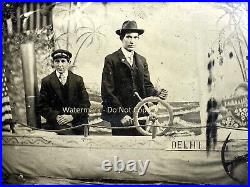Men in Boat Tintype Photo American Flag Gallery pose Delhil NY ca 1880




Tintype of Men in Boat. For offer, a nice old tin type photo. Fresh from a prominent estate in Upstate NY.
Never offered on the market until now. From a Broome County / Binghamton NY estate. Measures 3 1/2 x 2 1/2 inches.
Please see photos for details. This is a treasure you will not see again! Add this to your image or paper / ephemera collection. Perhaps important genealogy research importance too.
/ DEL-hy[3] is a town in Delaware County, New York, United States. The population was 4,795 at the 2020 census. [2][better source needed] The town is in the east-central part of the county and contains the village of Delhi. The State University of New York at Delhi is located in the town. The town is named after the city of Delhi, the capital of India.
[4] The name was in honor of founder Ebenezer Foote, who was known as "The Great Mogul". Another founder, Erastus Root, a rival of Foote, is responsible for the pronunciation. Root preferred the name "Mapleton". When he learned the town was to be named Delhi, he exclaimed, Delhi, Hell-high! Might as well call it Foote-high.
The town is the setting of the 1959 novel My Side of the Mountain by Jean Craighead George. Delhi was formed from the towns of Kortright, Middletown, and Walton, on March 23, 1798. It was named after Delhi in India. A tintype, also known as a melanotype or ferrotype, is a photograph made by creating a direct positive on a thin sheet of metal, colloquially called'tin' (though not actually tin-coated), coated with a dark lacquer or enamel and used as the support for the photographic emulsion. It was introduced in 1853 by Adolphe Alexandre Martin in Paris, [1] like the daguerreotype was fourteen years before by Daguerre.
The daguerreotype was established and most popular by now, though the primary competition for the tintype would have been the ambrotype, that shared the same collodion process, but on a glass support instead of metal. Both found unequivocal, if not exclusive, acceptance in North America. Tintypes enjoyed their widest use during the 1860s and 1870s, but lesser use of the medium persisted into 1930s[1] and it has been revived as a novelty and fine art form in the 21st century. It has been described as the first "truly democratic" medium for mass portraiture.
Tintypes were particularly used for portraits. They were at first usually made in a formal photographic studio, like daguerreotypes and other early types of photographs.
Later on tintypes were most commonly made by ferrotypists working in booths, tents, or the open air at fairs and carnivals, as well as by itinerant sidewalk photographers (with carts or wagons). Because the lacquered iron support was resilient and later did not need drying, a tintype could be developed and fixed and handed to the customer only a few minutes after the picture had been taken.
The tintype saw the Civil War come and go, documenting the individual soldier and horrific battle scenes. It captured scenes from the Wild West as it was easy to produce by itinerant photographers working out of covered wagons. They captured farming families in front of their new home (house portraits), emerging towns as well as the frontier landscape, for which large plates were used. It began losing artistic and commercial ground to higher quality albumen prints on paper in the mid-1860s, yet survived for well over another half century, living mostly as a carnival novelty. [4] The tintype's immediate predecessor, the ambrotype, was done by the same process of using a sheet of glass as the support. The glass was either of a dark color or provided with a black backing so that, as with a tintype, the underexposed negative image in the emulsion appeared as a positive. Tintypes were sturdy and did not require mounting in a protective hard case like ambrotypes and daguerreotypes.